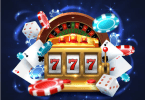Online gaming isn’t just about sitting down and queuing up for a match anymore. For a lot of players, the real hook is what happens around the game, the recognition, the competition, the comparisons that come with every win or loss. Over the past decade, that drive has turned into something bigger: a culture built almost entirely on comparison. It’s not just about whether you won. It’s about where you stand, how others see you, and what badge you’ve got next to your name.
Contents
Ranking Systems as Status Markers
You can’t really separate modern competitive games from ranking systems. Whether it’s the bronze-to-diamond climb in League of Legends, the MMR grind in Dota 2, or skill ratings in Overwatch, those numbers and tiers end up being more than stats. They’re shorthand for status. A high rank can instantly earn you respect. A low one can have people writing you off before the game even begins.
That instinct to compare spills over into other corners of digital life. Gamblers, for example, spend time weighing up platforms, reading reviews, and looking for the best gambling sites not just to play but to feel confident in where they’re investing their time and money. It’s the same psychology: rank, reputation, and the sense that standing matters.
Most ranking systems still trace back to Elo, the model first used in chess. Over the years, it’s been stretched and reshaped to fit games where millions compete at once. Bronze, silver, platinum, grandmaster, each division carries more than a name. Ask a player what rank they are and you won’t just get a number; you’ll hear pride, maybe frustration, sometimes even shame. That badge shapes how they see themselves and how they’re treated by the people they play with.
The Push and Pull of Social Comparison
Comparison isn’t all bad. For plenty of gamers, chasing the next rank is the reason they keep playing. That slow climb becomes a story you share with teammates, a collective effort where every win feels bigger than just another tick in the record. The recognition that comes with a promotion, or the relief of escaping a losing streak, creates real moments of connection.
But anyone who’s spent time in ranked queues knows the downside. These spaces are often where toxicity thrives.
Lower-ranked players are easy targets for blame. Higher-ranked players sometimes use their status as a weapon. What should be a fun match can turn ugly fast, with insults flying and fingers pointed.
Most big titles now have systems in place to curb that behavior, chat restrictions, temporary suspensions, or even permanent bans for repeat offenders. Some games use report features backed by automated reviews, while others rely on community moderation. The penalties don’t always stop the problem, but they do send a message: status isn’t a free pass to harass other players.
The pressure to protect or climb in rank pushes some toward shortcuts: buying boosted accounts, cheating, or smurfing on lower accounts to vent frustrations. None of it helps the community, but it makes sense once you see how much weight is tied to status. Those divides between the “good” players and the “bad” ones don’t just shape individual games. They shape the entire tone of the community.
Identity Within Gaming Communities
Step back and you’ll notice something: it’s not just players, it’s whole groups that start defining themselves through rank. Guilds, clans, or esports orgs wear their average rank like a badge. Belonging to a high-ranking group eases recruitment. Being locked in the lower divisions may prove to make it a difficult task to attract or retain players.
Within those groups, loyalty is quickly established. The common experience of struggling up a hill forms connections and group image, which is synonymous with individual results. Conform and you fare well. Fight back too often and you may find yourself on the bench.
That feeling of belonging has its cost effects, though it is powerful in nature. Competition between bands will be enhanced. Societies are divided into two: Superior and inferior. The higher scales one goes, the more exclusive things become, and inclusivity is usually the victim. What ought to be an inclusive space where players of all competencies go is a stratified hierarchy where a person is included based on their status.
The Ongoing Impact of Comparison
The culture of comparison has added depth to online gaming, but it’s also made the social side of play heavier. Ranking systems were designed to make matchmaking fairer. Now they shape identity, motivation, and community behavior. A badge or number can decide how you feel about yourself after a session and how much respect you get from strangers online.
It’s a complicated legacy. On one side, ranking motivates players to push harder, rewards effort, and gives communities common goals. On the other hand, it fuels toxicity, creates pressure that can push players toward cheating, and deepens divides between groups.
One thing is certain: comparison isn’t going away. It’s baked into how competitive games are designed and how players interact. Whether it’s climbing to the next tier, defending your reputation, or simply wanting to measure up, the urge to compare is what keeps many players logging in. And just like in other corners of digital life, from leaderboards to reviews, the question isn’t whether comparison shapes behavior—it’s how much.







